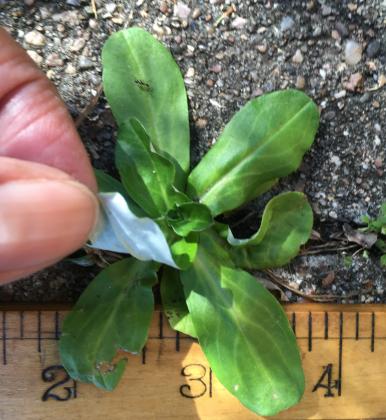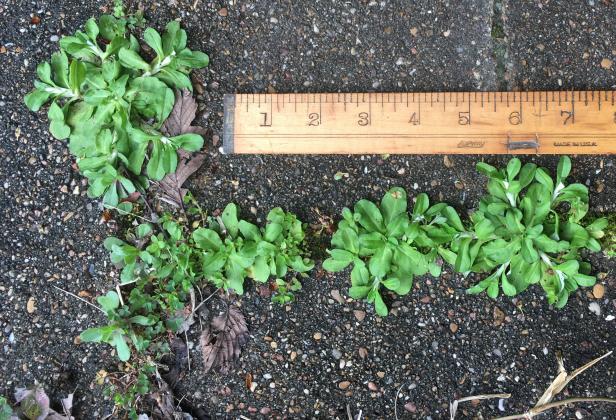Gamochaeta coarctata – Poor man’s chewing gum, down stuffing
Gamochaeta coarctata, cudweed, is common in Grimes County lawns and sidewalk cracks. The name cudweed is used by several similar plants. It also has synonyms and can appear in several forms. Some view these differences as varieties and others consider them to be separate species. When researching you should check members of the Gamochaeta, Gnaphalium and Pseudognaphalium genera.
Cudweed leaves first appear as a rosette lying flat to the ground in the winter and may persist year-round. They radiate straight out from the center without a stem. They are green and smooth, 1 to 2 inches long, alternate and obovate. That means teardrop-shaped with the small end attached to the center. Underneath, leaves are white due to dense white hairs that feel and look like felt. The 6 to 8-inch-tall stem comes up in spring and is white with the same hairs. Leaves get smaller the further up the stem they grow. Flowers, yellow, brownish green or purple, are clustered at the top of the stem with many heads arranged in a spike about ⅓ inch long. There are no ray flowers, petals. When mature, the seed head resembles dandelion fluff.
If you slowly tear a cudweed leaf or stem, you will see what looks like white cotton fibers. People who couldn’t afford down stuffing in pillows or mattresses used cudweed. I experimented by putting above ground parts in a spice grinder and finely chopping. The result was what looked and felt like a pale green cotton ball with green flecks. But it was sturdier and had more spring to it than cotton. I got similar results from fresh and dried parts but would dry it before stuffing anything. Even when cudweed leaves are dried, they remain green and pliable, they don’t get crumbly.
The common name is appropriate because chewing a leaf is like chewing gum. It isn’t sticky but like gum, it doesn’t go anywhere when chewed. It hardly has any flavor and you spit it out when you get tired of chewing. I don’t swallow it and didn’t find sources saying people ate this plant. In traditional medicine systems cudweed is chewed for diseases of the mouth and throat. Cudweed tea is used as a gargle, for sore throat, coughs, and other symptoms of the common cold. It is an ingredient in treatments for nervousness and sleeplessness. Externally it is used as a salve, poultice, body wash, eye wash and as steam for sweat baths for general aches and pains. Its smoke is sometimes held in the mouth and sometimes inhaled. It’s part of some smoking mixtures. The Native American Ethnobotany Database, naeb.brit.org, has more information. Following are two of several cudweed articles at the National Institutes of Health, ncbi.nlm.nih.gov.
• “Medicinal Plants Used in the Treatment of Human Immunodeficiency Virus”.
• “The Genus Gnaphalium L. (Compositae): Phytochemical and Pharmacological Characteristics”.
Some members of the Gamochaeta, Gnaphalium and Pseudognaphalium genera are in the Food and Drug Administration Poisonous Plant Database at fda.gov.
Deborah Richardson is a freelance reporter for The Examiner with a fondness for flora in its natural setting.



